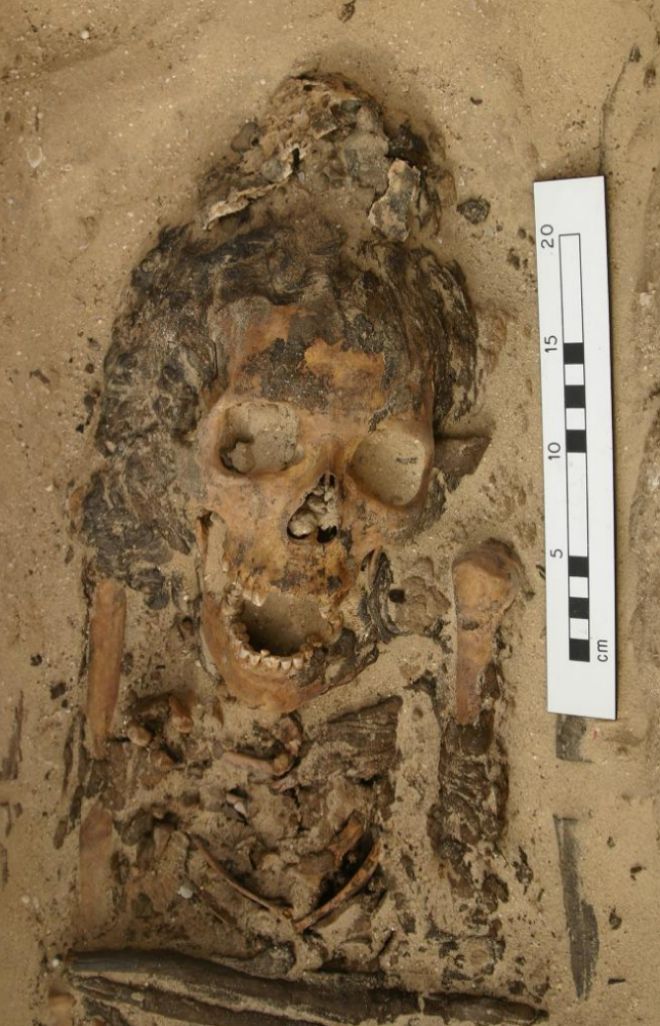For a millennium and a half, the visual representations of ancient Egypt showed their inhabitants carrying on their heads a white cone from which experts had failed to find any evidence. Until now. An archeological mission has just announced the discovery of the first evidence in a city grave founded by the heretic Ajenatón.
"The finding confirms that the cones on the head were actually used in Egypt," says Anna Stevens, an archaeologist at Monash University in Melbourne (Australia) and lead author of a study published in the journal Antiquity. The expedition has found two vestiges of white cones in separate burials located in Tell Amarna, the city established by Ajenatón halfway to Thebes and Memphis and dedicated to the worship of Atón.
The cones, made in wax, between 1347 and 1332 BC, are testimony to the time in which ancient Egypt was ruled by the first polytheistic monarch in history, husband of the elusive Nefertiti and father of the media Tutankhamun. "Now we can say that these cones were carried by the deceased but they could have fulfilled other functions, " Stevens acknowledges.
Until now, the only evidence of its existence was found in murals of the tombs belonging to the Pharaonic elite and scattered, also, in steles, papyri or coffins. In the images, the cone appears on men and women who participate in banquets, hunting or artistic activities, funerary rituals and cults of divinities.
The first of the cones was rescued in 2010 from a burial of the southern Amarna cemetery. It is linked to the body of a woman who died when her age ranged between 20 and 29 years. The tomb had remained intact and the cone was found in situ , still placed on its head and a well preserved hair. The piece that changes the known history was torn into six pieces, with total proportions of 80 millimeters in height and 100 millimeters in width.
The sequel was, on the other hand, dusted off five years later in the northern cemetery, in the bowels of a cavity reserved for an individual between 15 and 20 years old who was still in development and whose sex could not be determined. The misdeeds of the treasure hunters stirred the remains but the cone - found in three pieces, one of them larger - was safe from plundering, sheltered between the hair.
Both objects have a characteristic cream color and were damaged by the action of insects . Over the decades the usefulness of the cones has fueled exciting scientific debates. One of the most widespread hypotheses is that, from the new empire to the Ptolemaic era and its rales with Cleopatra, the cones were used as ointments and essences that, in contact with the environment, served to keep the body and hair clean and scented of the deceased
A remedy for the afterlife of which, however, the mission has not been able to find any evidence. "We could not find any essence in the excavated examples but it could have evaporated or be below the detention limits of the equipment used," the researcher slips.
« The exact function of the cones is difficult to establish . There is a small direct test that connects them with the religious reforms of Ajenatón », indicates the study. "The fact that it was not found elsewhere suggests that they were only occasional components of burials and that they were included under specific circumstances."
Female Fertility and Sensuality
One of the purposes could be related even to female "fertility or sensuality." His iconography appears in scenes linked to birth and family and in the settlements of Tell Amarna, ceramic figurines of naked women carrying the cones have been found, probably used in birth, fertility and healing rituals .
"Would cones be considered a powerful symbol of rebirth for women or perhaps a way to promote their fertility in the afterlife as a remedy for real-life problems?" The team of researchers says.
«The oddity of the cones, their association with at least one adult woman and family-centered concerns in personal cults in ancient Egypt make fertility and the remedy to problems linked to it an attempt to explain the presence of the cones in these burials », the study authors reply.
The archaeological team also considers it probable that the cones could have been used among the living , "although it is difficult to ensure how many times they were used and why." Questions that hope to respond by scrutinizing the sands of the still mysterious Amarna. «Excavations in its cemeteries continue. The objective of our work is to find out more about individuals who did not belong to the elite in ancient Egypt, including the reign of Ajenatón, ”concludes Stevens.
According to the criteria of The Trust Project
Know more- Science and Health
- science
Climate crisis: Greta Thunberg joins dozens of young people in Madrid for inaction against the climate emergency
ScienceClaves of the Climate March headed by Greta Thunberg in Madrid: Schedule, demonstration tour, concerts ...
COP25The Spaniards face climate change: "Society is in change mode"

